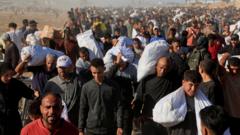Are US Aid Workers Injured in Gaza? Insights from the Humanitarian Foundation

A Deep Dive into the Current Humanitarian Crisis in Gaza: The Role of the Gaza Humanitarian Foundation and International Response
The ongoing humanitarian crisis in Gaza has reached alarming levels, with escalating violence and a complex web of political tensions complicating aid distribution efforts. Recently, reports emerged of an attack on the Gaza Humanitarian Foundation (GHF) during a relief operation, which has reignited discussions about the effectiveness and safety of aid delivery in conflict zones. This article explores the intricacies of the GHF's operations, the implications of international involvement, and the broader context of the ongoing conflict in Gaza.
Understanding the Gaza Humanitarian Foundation (GHF)
The Gaza Humanitarian Foundation, established in May 2023, aims to provide essential aid to the people of Gaza amidst a backdrop of continuous conflict. The organization has been the subject of controversy for its perceived alignment with Israeli and U.S. interests, which has raised questions about its neutrality and the safety of aid workers. Here’s what you need to know about the GHF:
- Purpose: The GHF aims to deliver food, medical supplies, and other essential items to Gazans affected by the conflict.
- Operational Base: The foundation operates primarily from various sites in southern and central Gaza, strategically located to reach those in dire need.
- Criticism: The GHF has faced backlash over its operational methods, particularly the requirement for large numbers of people to traverse combat zones to receive aid.
Recent Incident: Attack on Aid Workers
On a recent Saturday, the GHF reported an attack on its aid distribution center in Khan Younis, where two American workers were injured. The organization attributed the attack to militants, specifically blaming Hamas. According to GHF officials, the injured workers are in stable condition and receiving medical treatment. Fortunately, no other aid workers or civilians were harmed during the incident.
The Broader Context of Violence in Gaza
As the GHF continues its operations, the situation in Gaza remains perilous. Reports indicate that over 400 Palestinians have been killed while attempting to access food aid since the foundation commenced its work. These statistics highlight the inherent dangers associated with aid distribution in conflict zones, where the risk to life is ever-present.
The Role of International Actors in the Gaza Crisis
The involvement of international players, particularly Israel and the United States, has been a significant factor in shaping the humanitarian landscape in Gaza. The Israeli military launched its campaign against Hamas following a series of attacks that resulted in approximately 1,200 Israeli deaths and the taking of hostages. The subsequent military operations have led to a staggering death toll in Gaza, with reports indicating over 57,000 fatalities since the conflict escalated.
Impact of U.S. Policies on Aid Distribution
The U.S. has played a crucial role in supporting the GHF and framing the narrative surrounding aid distribution in Gaza. However, this backing has also led to accusations of bias, with critics arguing that U.S. policies favor Israeli interests over the humanitarian needs of Gazans. The GHF's operations are viewed by some as a mechanism to prevent aid from reaching Hamas, complicating the already challenging landscape of humanitarian assistance.
Ceasefire Talks and Their Implications
In the midst of this crisis, there have been indications that Hamas is open to discussions regarding a ceasefire. The group has expressed willingness to negotiate terms proposed by the U.S., which reportedly involve a staggered release of Israeli hostages in exchange for Palestinian prisoners. This potential shift in dialogue raises important questions about the future of humanitarian aid in Gaza and the role of organizations like the GHF.
Key Points of the Proposed Ceasefire
- Staggered Release of Hostages: The plan includes a phased approach to releasing Israeli hostages held in Gaza.
- Palestinian Prisoners: In exchange for hostages, there are discussions around the release of Palestinian prisoners in Israeli custody.
- GHF's Role: Hamas has called for the GHF to be dissolved, insisting that aid distribution should be managed solely by the UN and its partners.
The Humanitarian Impact of Military Operations
The ongoing military operations in Gaza have devastating humanitarian consequences. The GHF reports that many civilians have lost their lives while trying to obtain food and medical assistance. The UN and local health authorities continue to document the escalating death toll, which has now surpassed 57,000 since the outbreak of hostilities. This staggering figure underscores the urgent need for a reevaluation of how aid is delivered in conflict zones.
Challenges Facing Humanitarian Aid Workers
Humanitarian aid workers face numerous challenges in conflict-affected areas, including:
- Security Risks: The threat of violence from various factions poses a significant risk to aid workers and the populations they aim to serve.
- Access Issues: Ongoing military operations can restrict access to critical areas where aid is needed most.
- Bureaucratic Obstacles: Navigating the complex political landscape can hinder the timely delivery of assistance.
Public Sentiment and Global Reactions
The public's response to the humanitarian crisis in Gaza varies significantly across the globe. Many advocate for increased humanitarian support and a ceasefire, while others focus on the political dimensions of the conflict. The polarized reactions reflect broader geopolitical tensions and differing perspectives on the causes of the violence.
Calls for Action from Global Leaders
World leaders have increasingly called for an end to hostilities and a focus on humanitarian solutions. The situation in Gaza has captured international attention, leading to widespread protests and demands for urgent action. Key themes in these appeals include:
- Immediate Ceasefire: Advocates stress the need for an immediate halt to hostilities to allow for humanitarian aid to reach those in need.
- Increased Aid Support: Calls for countries to increase their humanitarian contributions to support the people of Gaza.
- Long-term Solutions: Emphasis on the importance of addressing the root causes of the conflict to prevent future crises.
Moving Forward: The Future of Humanitarian Aid in Gaza
As the situation in Gaza continues to evolve, the future of humanitarian aid hangs in the balance. The GHF's operations have sparked intense debate regarding the best way to deliver assistance while ensuring the safety of aid workers and recipients alike. The potential for a ceasefire could pave the way for a more effective and secure distribution of aid, but significant obstacles remain.
The Role of Community Involvement
In addition to international efforts, local communities play a vital role in navigating the complexities of humanitarian aid. Community-led initiatives can enhance the effectiveness of aid distribution by:
- Building Trust: Local organizations can foster trust within the community, ensuring that aid reaches those who need it most.
- Identifying Needs: Community leaders can provide insights into the specific needs of their populations, allowing for tailored assistance.
- Enhancing Security: Local involvement can improve safety during aid distribution, reducing the risks faced by external aid workers.
Conclusion: A Call for Compassion and Action
The humanitarian crisis in Gaza demands urgent attention and a concerted effort from the international community. As we navigate the complexities surrounding aid distribution and the ongoing conflict, it is crucial to prioritize the safety and well-being of those affected. The recent attack on GHF workers highlights the dangers inherent in these efforts, but it also serves as a reminder of the resilience and strength of communities striving for survival amidst chaos.
As we consider the future of humanitarian aid in Gaza, it is imperative to advocate for solutions that not only address immediate needs but also pave the way for long-term peace and stability. The path ahead is fraught with challenges, but through compassion, collaboration, and a commitment to humanitarian principles, we can work towards a brighter future for Gaza.
FAQs
What is the Gaza Humanitarian Foundation (GHF)?
The GHF is an organization established to provide humanitarian aid to the people of Gaza, aiming to deliver essential supplies amidst ongoing conflict.
Why has the GHF faced criticism?
The GHF has been criticized for its perceived alignment with Israeli and U.S. interests, raising concerns about its neutrality in delivering aid.
What are the current conditions for civilians in Gaza?
Conditions in Gaza are dire, with a high death toll and significant challenges in accessing food and medical supplies due to ongoing military operations.
What is the status of ceasefire talks involving Hamas?
Hamas has indicated a willingness to engage in ceasefire negotiations, linking discussions to the release of hostages and humanitarian aid distribution.
How can local communities contribute to humanitarian efforts?
Local communities can enhance the effectiveness of aid distribution by building trust, identifying specific needs, and improving security during operations.
As we reflect on the ongoing crisis, how can we collectively work towards a sustainable solution for the people of Gaza? #GazaCrisis #HumanitarianAid #PeaceInGaza
Published: 2025-07-05 14:45:25 | Category: technology



